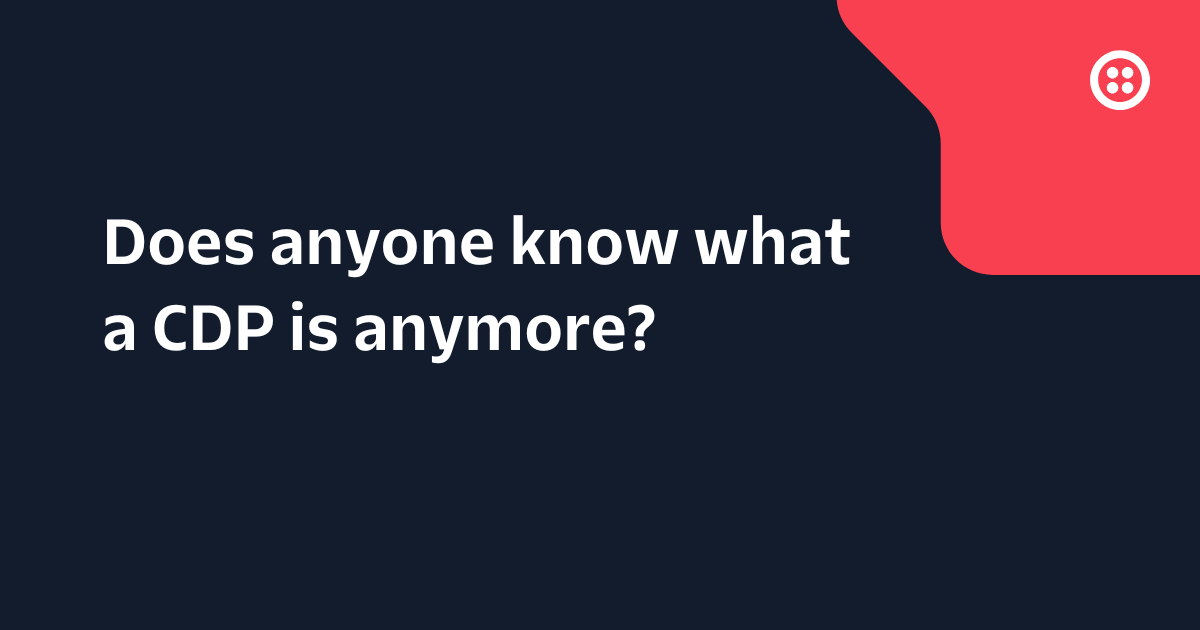The Privacy-Personalization Paradox: Dispelling The Myth With First-Party Data
Time to read: 6 minutes
The Privacy-Personalization Paradox: Dispelling The Myth With First-Party Data
At the beginning of 2024, Google finally made good on its promise to deprecate third-party cookies by restricting them for 1% of Chrome users. And in spite of recently announced delays, the company plans to do so for the entire Chrome user base.
Although Google’s move was dubbed “the death of the third-party cookie,” Chrome is not the first browser to limit third-party tracking. Safari and Firefox did so years prior.
But as the world’s leading internet browser, Chrome’s move has significantly impacted advertisers already grappling with consumers who increasingly prioritize personalization and privacy. (Not to mention ever-stricter regulations, such as the European Union’s new Data Act.)
Privacy is particularly important to people in their 20s and 30s who are exercising their data subject access rights more than any other demographic. But the demand for privacy is high across all age groups. Roughly 8 in 10 consumers have deleted an app and refused to share personal data due to privacy concerns.
These calls for privacy seemingly contradict the high premium consumers place on personalization. (In our recent State of Personalization Report, 2024, roughly 6 in 10 business leaders say personalization has helped them improve customer retention.)
How are businesses expected to tailor any aspect of the customer experience without third-party cookies?
The answer lies in zero- and first-party data.
The advantage of zero- and first-party data
Before we go any further, let’s get some terminology out of the way. Customers share zero-party data when they voluntarily disclose information about themselves, such as by completing a survey. Meanwhile, first-party data is shared through direct interactions on owned channels – think website purchases or mobile app usage.
Both allow businesses to support individualization without cookies. For example, it allows an eCommerce retailer like ASOS to uses the customer’s previous purchases to recommend products on their app.


But notice how ASOS also provides a product ranking disclaimer, which takes users to a page where they can learn how their data is being used.


This is the new reality businesses have to cater to – providing customers with a personalized experience, while also ensuring data is being used in a way that builds trust.
We’ve already seen how failing to disclose how you use customer data can result in lasting reputational damage; the ramifications of the 2018 Cambridge Analytica controversy are still being felt years later.
But this reputational damage is increasingly being paired with legal implications. Google has only recently settled a consumer privacy lawsuit alleging the company tracked people using the incognito browsing mode without notifying them.
These lawsuits have only made consumers more wary of businesses collecting their information – only half believe businesses will protect their data and use it responsibly.
For organizations concerned that zero- and first-party data will not support the kind of personalization that third-party cookies allow, they are increasingly turning to a customer data platform (CDP) for help.
With a CDP, brands can securely and compliantly collect first-party data about how customers engage with their business. The CDP pulls data from all of your sources, such as mobile apps and ad platforms, leaving no customer touchpoint behind. Plus, it contains important security and compliance guardrails, such as proactively blocking the collection of certain data.
This was precisely why Quartz, the digital-first media outlet, partnered with Segment Quartz to design a data collection infrastructure that respects users’ privacy and provides value in return for their data. Quartz leveraged the data collection and synthesis features of Twilio Segment alongside the privacy, consent, and regulatory compliance tools.
“We had to rethink the advertising revenue model, and to do it in a future-proof way. It now has to be customer-centric.” – Daniel Alvarez, Quartz’ Chief Product Officer
Navigating the paradox with a CDP
To help you jump-start this mission-critical journey, here are three ways current Segment customers are using a CDP to achieve privacy-first personalization
1. Collecting first-party data
Zero or first-party data is generally regarded as the most valuable data for personalizing the customer experience, and the safest type of data to collect because you can create a trail proving exactly where it came from and why it was collected
But in order to start collecting first-party user data across the many channels you use, your business needs a customer data platform solution, like Twilio Segment. It collects first-party data from many different sources and consolidates them into one platform, giving businesses a unified view of all their customers in real time.


From there, your business can send this data to downstream channels – like email, SMS, or digital advertising platforms – to provide unified, personalized experiences for each and every customer.
And, of course, it allows your business to automate most or all of these actions. This empowers your team to spend more time building personalized marketing and advertising campaigns that boost engagement and drive conversions.
“Twilio Segment proved that our first-party data was more valuable than any third-party data – even third-party tracking cookies – could provide. We couldn’t believe the advertising results we witnessed by using in-house data models and Twilio Segment.” – Martin Brummerstedt, Data Scientist & Digital Project Manager at Stylepit
So, how can you collect first-party user data? While there are many ways you can learn more about your customers, here are a few brands commonly use to learn more about their customers:
- Account creation/sign-up
- Browsing history
- Lead generation forms (newsletter sign-up, content downloads, demo requests, etc.)
- Purchase history
- Customer reviews
- Surveys and polls
- In-person and virtual events
However, if you choose to collect first-party data, remember to prioritize quality over quantity. You want this data to be accurate and reliable, as it will fuel all of your customer communications, advertising campaigns, marketing initiatives, and more.
2. Acquiring new customers through lookalike audiences
They say you are the sum total of those you surround yourself with.
And when it comes to creating solid lookalike audiences on your advertising platforms, that concept has never been more true. Lookalike audiences are a great way to harness first-party data that many large advertising platforms such as Facebook, Google, and Twitter have already collected as a tool to target audiences that are ‘similar’ to your existing customers.
Here’s how it works: By collecting valuable first-party data via Twilio Segment (which then “automagically” sends a coded list of your existing customer phone numbers or email addresses to an ad platform of your choice, the platform then ‘matches’ and identifies the customers shared between the company and the ad database. Then, the platform combines the matched users and finds similar customers to target your ads using its own first-party data.
This is a relatively inexpensive and trustworthy way to reach new valuable customers using the high-quality, first-party data of ad platforms like Facebook and Google. You can also feel confident keeping your customer data safe while also extending your reach using their advanced models to identify similar users to potentially convert on your site.
Twilio Segment customer Veronica Beard did just that, and saw an 11% increase in return on ad spend (ROAS) and a 20% decrease in customer acquisition cost by doing so.
3. Tying offline and online behavior
The customer journey is rarely linear, with over 90% of individuals moving between devices to complete a task.
AdTech platforms have traditionally used third-party cookies to identify users across the web, but in this privacy minded age businesses are looking for new ways to build a complete picture of their customers across channels.
Identity resolution is fast emerging as a solution. It allows you to understand a user’s interaction across web, mobile, server, and third-party partner touchpoints in real time, using an online and offline ID graph with support for identifiers like cookie IDs, device IDs, emails, and custom external IDs.
Let’s use a real-world example.
Let’s say a customer shows up on your website and registers with their email and phone number. The email is formatted in all lowercase, like <name@domain.com>, and the phone number is formatted as <+1-123-456-7890>. So far, so normal.
Then, the customer calls your call center, but their phone number is formatted as <1 (123) 456-7890>. The events from the call center will not be stamped onto the same customer profile that was generated from the earlier website events, because the phone number formatting doesn’t exactly match.
Using a identity resolution system like Twilio Segment, you can automatically match many identifiers to the same person (such as <user_id>, <email>, <phone>, <device_id>, and <anonymous_id>), without having your team write SQL-heavy queries all day long.
Learn how Fender drove a 5% increase in active paying users for Fender Play using Segment’s identity resolution system.
Data laws are constantly evolving. Yet, these changes all have one thing in common – prioritizing privacy and data subject rights. Consequently, organizations need to find privacy-conscious ways to engage customers and tailor each experience.
Chris Koehler is Chief Marketing Officer at Twilio.
Related Posts
Related Resources
Twilio Docs
From APIs to SDKs to sample apps
API reference documentation, SDKs, helper libraries, quickstarts, and tutorials for your language and platform.
Resource Center
The latest ebooks, industry reports, and webinars
Learn from customer engagement experts to improve your own communication.
Ahoy
Twilio's developer community hub
Best practices, code samples, and inspiration to build communications and digital engagement experiences.


